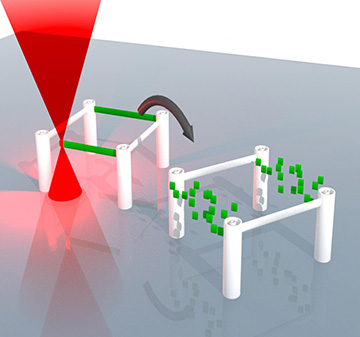
The KUT team developed an erasable 3-D printing material (green bars) that could be laser-written (left) and then selectively dissolved away (right), allowing the creation of partly removable laser-written scaffolds for micro- and nanotechnology. [Image: KIT]
When engineers build a complex structure such as a bridge or office tower, part of the effort involves erecting a scaffold, pieces of which are removed as the larger structure takes shape. A selectively removable scaffold could also prove handy in the much-smaller-scale world of 3-D printing, and in particular for the direct laser writing (DLW) used to build up structures such as photonic crystals, micromotors and artificial cells. But such selectively removable DLW elements have been tough to achieve.
Now, researchers from the Karlsruhe Institute of Technology (KIT), Germany, have developed an “erasable ink” for DLW 3-D printed elements that could provide just such a capability (Angew. Chem. Intl. Ed., doi: 10.1002/anie.201701593). The team believes that the process—which can be combined strategically with durable, standard DLW materials to create scaffolds that can be chemically snipped away at preselected points—could find use in fabrication of complex conductive surfaces, scaffolded 3-D cell cultures for biomedical research, and more.
Cleavable bonds
DLW works by scanning a femtosecond pulsed laser across a liquid photoresist substance (either by moving the working stage or by adjusting the beam path). As the laser selectively hits the target, nonlinear multiphoton absorption causes the photoresist material to polymerize, allowing complex structures to be built up a layer at a time. The method has become an important part of the micro- and nanotechnology toolkit, and is now routinely used to build complex 3-D structures for photonics, microfluidics, tissue engineering and a range of other areas.
To extend the technique to provide laser-written scaffolds for which microstructures could be removed on demand, the KUT team—led by OSA Fellow Martin Wegener and Christopher Barner-Kowollik—looked directly at the chemistry of the photoresist itself. Specifically, they set themselves the task of designing a photoresist that would include phenacyl sulfide. That chemical, when activated by 700-nm light, forms disulfide bonds that are robust—but the bonds also fall apart easily in the presence of another, commercially available chemical trigger, dithiothreitol (DTT). A simple DTT chemical bath thus can erase the scaffold structures.
The team was able to create “a variety of structures comprising line arrays, woodpile-
like structures, layers, and blocks” using the photoresist, and thereby to demonstrate its potential use in production 3-D printing—the “fundamental units” of which, the authors point out, “are always fine lines, free-standing units, layers or bulk material.”
Getting to a selectively erasable scaffold
Making the scheme selective—such that parts of a scaffold might be removed while other sections remain intact—involved combining the new photoresist with partial scaffolds made of acrylate-based photoresist materials that won’t break down in the presence of DTT. To test the system out, the KUT researchers first used DLW to write a repeated linear array of control structures (at 300-nm spacing) in the acrylate-based material. They then wrote in additional fine linking structures across those lines using their erasable phenacyl sulfide material. The result was a network of complexly linked erasable and non-erasable bonds. Subsequent exposure to DTT broke only the erasable bonds, leaving the original control structures intact—a finding confirmed with scanning electron microscopy of the surface.
The team stresses that the new erasable resist substance can be “readily synthesized,” and that the other components of the process, such as DTT, are commercially available. As to specific applications, the researchers suggest a number of candidates, including processes that need durable scaffolding materials that can still be removed during or after fabrication—“for example, when using expensive or unique samples,” or in “complex architectures in need of a removable support frame.”
